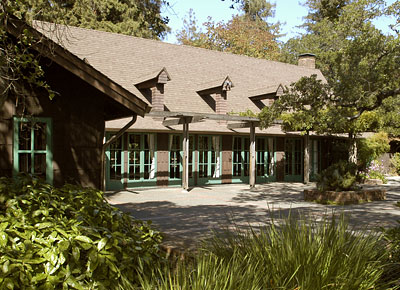National Register of Historic Places in Marin County
Outdoor Art Club
1 West Blithedale Avenue at Throckmorton
Mill Valley
Thirty-five ladies, led by Mrs. Lovell White, wife of the President of the Tamalpais Land & Water Company, decided to band together to save the natural beauty of the city and the surrounding hills and canyons leading to Mount Tamalpais. The Outdoor Art Club by-laws state the purpose of the Club:
To preserve the natural scenery of Mill Valley and the surrounding country, to beautify the grounds around public buildings, to endeavor to create public sentiment against the wanton destruction of birds and game, and in all other directions to encourage the development of outdoor art as well as to engage in what is known as civic, social and literary work.
The ladies commissioned Bernard Maybeck to design their clubhouse.
Maybeck was strongly influenced by the Arts & Crafts movement of Europe, particularly by the Englishmen, Vosey and Baillie Scott. This movement, begun in the fine arts, spread naturally to architecture, first appearing in this country on the East Coast. It was introduced on The West Coast by Maybeck, along with Polk, Coxhead and Morgan in the San Francisco Bay Region, and Gill and Greene & Greene in Southern California.
Arts & Crafts was a definite turn around from Victorian, bringing simplicity to building form with man made rather than ornate, machine-turned decoration. Paramount was the requirement that structure fit with the land form rather than proclaiming the building's dominance over the land. To better achieve this landbuilding relationship, natural unpainted wood was normally used both for exterior and interior surfaces. Maybeck did this far better than most, always in his own individual manner, and often with humor,
The original Maybeck Outdoor Art Clubhouse is unaltered. A 1923 addition by a local architect has not been changed since then, and is compatible with the Maybeck structure.
Extracted from the NRHP nomination dated 31 July 1978.

The Outdoor Art Club is also California Landmark 922.
